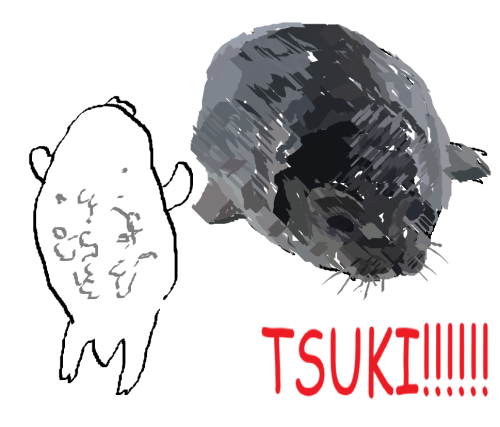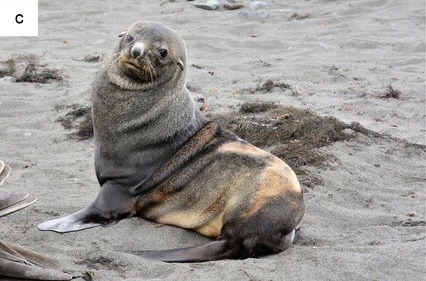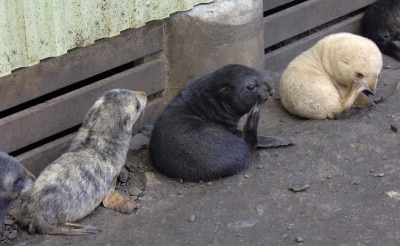Today's Seals Are: MAMA, LOOK!
Today's Seals Are: MAMA, LOOK!

More Posts from Fursealfan and Others
please stop calling the california sea lions that are acting abnormally “demonic”. they are experiencing domoic acid toxicosis. domoic acid (DA) is a neurotoxin that is made by an algae called pseudo-nitzschia australis. fish eat the algae and the sea lions eat the fish. this buildup of DA in their system is what causes the behaviours we’re seeing. symptoms of DA toxicosis include: lethargy, disorientation, unpredictable behaviour, seizures, brain damage, and eventually death.
as far as we know, there have only been two unprovoked sea lion attacks on beaches. the vast majority of sea lions with DA toxicosis are not aggressive unless provoked. they are disoriented and they are acting out of fear.
DA is naturally occurring, but the algal blooms of pseudo-nitzschia australis have been increasing due to rising temperatures from climate change and water pollution. we are doing this to them.
affected sea lions seem to have pretty much a 50% chance of survival with treatment. they need IV fluids to flush out the toxin and some will need seizure medication as well. the marine mammal care center is completely overwhelmed with the amount of sick sea lions they are taking in and they need funding to keep up. you can donate to them here.
always stay at least 45 meters / 50 yards away from marine mammals! it protects both them and us!
Sk'aliCh'elh-tenaut, also known as “Tokitae” or “Lolita”, was a Southern Resident killer whale likely from L-pod. She was born around the mid-1960s. Many suspect her mother is L25 “Ocean Sun”, but there has never been confirmation.
In August 1970, Sk'aliCh'elh-tenaut was one of around 80 killer whales rounded up for capture in Penn Cove, Washington. Based on her size, she was between 2-7 years old at the time. In the capture, led by Ted Griffin and Don Golsberry, 5 whales drowned and 7 whales, including Sk'aliCh'elh-tenaut, were taken away.
Sk'aliCh'elh-tenaut was purchased by a veterinarian at Miami Seaquarium named Jesse White for $20,000. She was transported to Miami Seaquarium in September 1970. White named her “Tokitae”, a Coast Salish word that roughly translates to “nice day” or “pretty colours” in English.
She was originally kept separately from the other orca, a male Southern Resident called Hugo. Hugo had been captured 2 years prior from Vaughn Bay, Washington.
Sk'aliCh'elh-tenaut and Hugo would often talk to each other between tanks, Southern Residents have a unique language which includes specific dialects within their pods, meaning that the two of them were able to communicate in ways that they could not with any other population. Miami Seaquarium eventually placed them together in a single 80-by-35 ft tank. The they mated often, but never had any living calves. Sk'aliCh'elh-tenaut was given the stage name “Lolita”.
Hugo experienced severe stress due to his situation. In March 1980, he died after ramming his head into the wall of the tank.
Sk'aliCh'elh-tenaut was housed with other cetaceans, but remained the only orca at the aquarium for the rest of her life. Despite her isolation, she held on to her home. She was heard multiple times throughout her decades in captivity singing a song that is only heard within L-pod.
In 2015, NOAA removed the exclusion of captive whales from the Endangered Species Act and included Sk'aliCh'elh-tenaut in the listing of Southern Residents. NOAA stated there was a “strong case” that she was a Southern Resident after analysing her mitochondrial and microsatellite DNA. However, because she was captured 2 years before the Marine Mammal Protection Act, Sk'aliCh'elh-tenaut was considered “pre-Act”, meaning she did not qualify under it.
The Lummi Nation never stopped fighting for Sk'aliCh'elh-tenaut to be brought home. They consider her a relative. In July 2019, two Lummi women, Squil-le-he-le and Tah-mahs, invoked the Native American Graves Protection and Repatriation Act (NAGPRA) in an attempt to bring Sk'aliCh'elh-tenaut home. NAGPRA gave them legal grounds to sue Miami Seaquarium if they refused to return Sk'aliCh'elh-tenaut to the Salish Sea.
In August 2019, the Lummi gave her the name “Sk'aliCh'elh-tenaut”, which roughly translates to “member of Sk’aliCh’elh” in English. Sk’aliCh’elh being a family of orcas in the Salish sea.
Squil-le-he-le visited Sk'aliCh'elh-tenaut in Miami and performed healing songs for her. Sk'aliCh'elh-tenaut was very receptive to this. Squil-le-he-le was quoted saying “She was singing with me. She was vocalizing with me,” in an interview with The Planet.
In March 2023, the Miami Seaquarium (now owned by The Dolphin Company) partnered with Friends of Toki and began the process of transferring Sk'aliCh'elh-tenaut to a sea pen in her home waters.
This decision was controversial given Sk'aliCh'elh-tenaut’s age (around her late 50s) and her chronic health conditions. She hadn’t been transported anywhere in over 50 years, causing concern for the stress that transport to Washington could cause her. There were also concerns that she might not be able to survive the re-exposure to the bacteria in the ocean after living in a tank of clorinated water for so long, or that she could possibly expose the wild Southern Residents to the infections she developed in captivity.
Others, especially the Lummi, argued that she deserved to live the remainder of her life in her home waters, which she clearly remembered.
In August 2023, the Miami Seaquarium announced that Sk'aliCh'elh-tenaut had passed away. Her cause of death was attributed to multiple chronic health conditions. On the day of her death, over 3000 miles away, members of all 3 Southern Resident pods (J,K, and L) were gathered together in what is known as a “superpod”. Gatherings of multiple Southern Resident pods have become more rare in recent years.
The Lummi were not consulted before the autopsy was performed.
Finally, in September 2023 her ashes were returned home and there were multiple ceremonies laying her to rest.
No Southern Resident had been seen in Penn Cove since the captures in the 1970s, but in November 2024, L-pod returned. Among them was Ocean Sun.
Footage: Kat Martin, ScubaFilmFactory, Miami Herald, KING 5 Seattle, AnaCarlaNJ, H2Omammals, DaddysJournie, KING 5 Seattle
Audio: Susannah Joffe, sacredsea.org
tsuki oh how i love you


let’s swim with mama
welcome to my blubbery blog!!! 🦭🦦🐋🐬🫧
i’m currently a volunteer at an AZA accredited aquarium, i hope to study marine environmental science in the future and work in conservation and education! my primary interests are in northern fur seal biology and southern resident killer whale behaviour, but i love all marine mammals!
i support accredited* zoos and aquariums! i do however hope that we can move away from them in the future. i think that conversations about the ethics of captivity are important and should always be centered around the wellbeing of the captive animals. i encourage caution and use of critical thinking around both anti and pro captivity arguments. i’m always happy to answer any questions about the practices of AZA accredited zoos and aquariums!
*there are some accredited zoos and aquariums (such as seaworld) that i am heavily critical of, but it’s unfortunately a complicated issue that isn’t realistic to have black and white opinions on.
marine mammal rescue, conservation, and research organisations:
alaska sealife is center
vancouver aquarium marine mammal rescue society
center for whale research
SR3
marine mammal care center
Animal welfare advocacy should be about the animals, not an agenda
Wildlife tourism isn’t always a more ethical choice.

I often see people who are under the assumption that wildlife tourism is free from ethical concerns, or that it’s inherently a more ethical choice than visiting a zoo/aquarium.
Wildlife tourism encompasses a wide variety of activities that involves watching wildlife in engage with their natural habitat. This includes safaris, whale watching, birding, photography tours, and a host of other activities. Wildlife tourism by itself can be an ethical way to see wildlife, however that is not always the case. There’s actively many harmful parts of wildlife tourism, that people may overlook since the animals are “free.”
So.. what would be some examples of unethical wildlife tourism?
- Whale petting in Baja Mexico. This activity actively contributes to the habituation of whales and disrupts their natural behaviors. Habituated whales are at a higher risk of encountering boat strikes - which can lead to physical injury or even death.
- Fake/bad acting sanctuaries. Sanctuaries are not always ethical, and many advertise activities such as elephant rides, elephant bathing, and advocate for people to touch/hold animals. The training methods they often utilize use fear or coercion, this is often actively stressful to the animals, and can be particularly dangerous to the tourists engaging with these animals.
- Swimming with whales. Studies show that commercial swim with whale tours can negatively impact the behaviors of some baleen whale species. These behaviors include avoidance and decreased rest time.
Spoiler: Injured wildlife

Is there ethical wildlife tourism?
Absolutely! Wildlife tourism should be done with respect for the animals. There should be careful steps taken to avoid habituation and harassment of wildlife.
Some of my favorite options include visiting a national park, bird watching, and doing careful research to find ethical whale watching companies. Additionally, many AZA accredited zoos offer animal interactions that are done in a safe & non-stressful manner for the animals. These may even include giraffe feedings and up close educational encounters.

lets kissy mama
Begging you for some pinnipeds any pinnipeds please
Piebald Northern fur seal

Atypical colored Antarctic fur seal! With the orange, white, and grey they look calico.

Leucistic Antarctic fur seal

Interesting gang of Antarctic fur seal, one is leucistic and one almost looks brindle?

Leucistic southern elephant seal

Northern fur seal labeled as albino and partial albino (leucistic?) by some sources. NOAA says albino and they are experts.

Albino harbor seal

Albino ringed seal

Melanistic grey seal

i love this "with mama" meme. mm yes give me more baby animals with mmama.
-
 denverzq liked this · 4 days ago
denverzq liked this · 4 days ago -
 theunconsecrated liked this · 4 days ago
theunconsecrated liked this · 4 days ago -
 cataqu33rz liked this · 4 days ago
cataqu33rz liked this · 4 days ago -
 itwasyummy liked this · 4 days ago
itwasyummy liked this · 4 days ago -
 tamatoes402 liked this · 4 days ago
tamatoes402 liked this · 4 days ago -
 qualitystrangetrash liked this · 4 days ago
qualitystrangetrash liked this · 4 days ago -
 crowpea liked this · 4 days ago
crowpea liked this · 4 days ago -
 pchelik-please liked this · 5 days ago
pchelik-please liked this · 5 days ago -
 managerie76 liked this · 5 days ago
managerie76 liked this · 5 days ago -
 perfidiousperegrin liked this · 5 days ago
perfidiousperegrin liked this · 5 days ago -
 1ilbasturd liked this · 5 days ago
1ilbasturd liked this · 5 days ago -
 vivid-does-stuff liked this · 5 days ago
vivid-does-stuff liked this · 5 days ago -
 kittyprincess756 liked this · 5 days ago
kittyprincess756 liked this · 5 days ago -
 galpal-galaxy liked this · 5 days ago
galpal-galaxy liked this · 5 days ago -
 randomfangirl2002 liked this · 5 days ago
randomfangirl2002 liked this · 5 days ago -
 epoxide reblogged this · 5 days ago
epoxide reblogged this · 5 days ago -
 minty-0ne liked this · 5 days ago
minty-0ne liked this · 5 days ago -
 reanimationstation liked this · 5 days ago
reanimationstation liked this · 5 days ago -
 stitchnerd reblogged this · 5 days ago
stitchnerd reblogged this · 5 days ago -
 ugly-bug-starscream liked this · 5 days ago
ugly-bug-starscream liked this · 5 days ago -
 less-perfect-than-lore liked this · 5 days ago
less-perfect-than-lore liked this · 5 days ago -
 dawnsaber reblogged this · 6 days ago
dawnsaber reblogged this · 6 days ago -
 r-osehips liked this · 6 days ago
r-osehips liked this · 6 days ago -
 clydiavandyke reblogged this · 6 days ago
clydiavandyke reblogged this · 6 days ago -
 katebihshop reblogged this · 6 days ago
katebihshop reblogged this · 6 days ago -
 attackoftheskydancers reblogged this · 6 days ago
attackoftheskydancers reblogged this · 6 days ago -
 kamilligan liked this · 6 days ago
kamilligan liked this · 6 days ago -
 seen-the-stars liked this · 6 days ago
seen-the-stars liked this · 6 days ago -
 elizaisthetruehero reblogged this · 6 days ago
elizaisthetruehero reblogged this · 6 days ago -
 damejoansutherland liked this · 6 days ago
damejoansutherland liked this · 6 days ago -
 jackalopeisaac liked this · 6 days ago
jackalopeisaac liked this · 6 days ago -
 kaiyves-backup liked this · 6 days ago
kaiyves-backup liked this · 6 days ago -
 queenofnots reblogged this · 6 days ago
queenofnots reblogged this · 6 days ago -
 steelplatedhearts liked this · 6 days ago
steelplatedhearts liked this · 6 days ago -
 sparklinglakemonster reblogged this · 6 days ago
sparklinglakemonster reblogged this · 6 days ago -
 sparklinglakemonster liked this · 6 days ago
sparklinglakemonster liked this · 6 days ago -
 sharkbaitouhaha reblogged this · 6 days ago
sharkbaitouhaha reblogged this · 6 days ago -
 spiders-hth-is-an-outlier liked this · 6 days ago
spiders-hth-is-an-outlier liked this · 6 days ago -
 mariacallous reblogged this · 6 days ago
mariacallous reblogged this · 6 days ago -
 mariacallous liked this · 6 days ago
mariacallous liked this · 6 days ago -
 bluestockingbaby liked this · 6 days ago
bluestockingbaby liked this · 6 days ago -
 coralreeferband reblogged this · 6 days ago
coralreeferband reblogged this · 6 days ago -
 mini-wrants reblogged this · 6 days ago
mini-wrants reblogged this · 6 days ago -
 maiiau reblogged this · 6 days ago
maiiau reblogged this · 6 days ago -
 demimonde-semigoddess liked this · 6 days ago
demimonde-semigoddess liked this · 6 days ago -
 demimonde-semigoddess reblogged this · 6 days ago
demimonde-semigoddess reblogged this · 6 days ago -
 swirlingflight reblogged this · 6 days ago
swirlingflight reblogged this · 6 days ago -
 batplushies reblogged this · 6 days ago
batplushies reblogged this · 6 days ago
